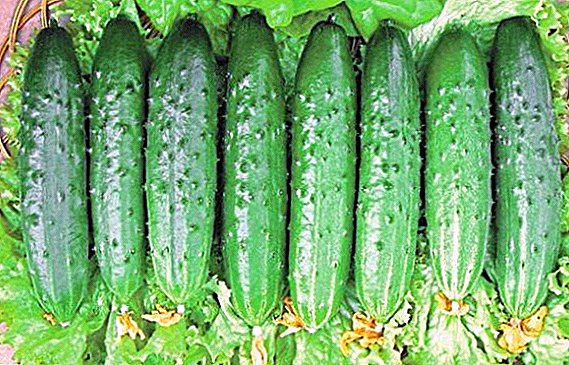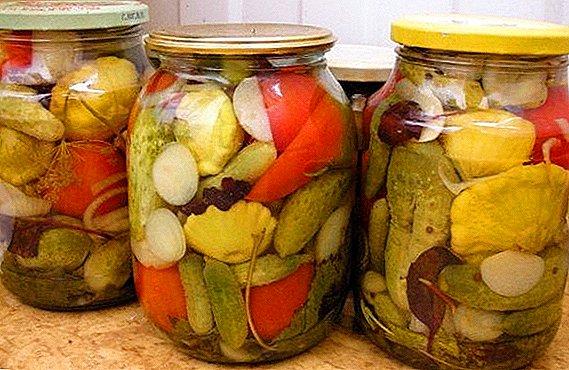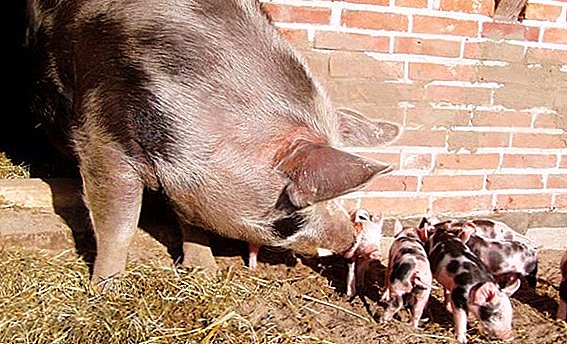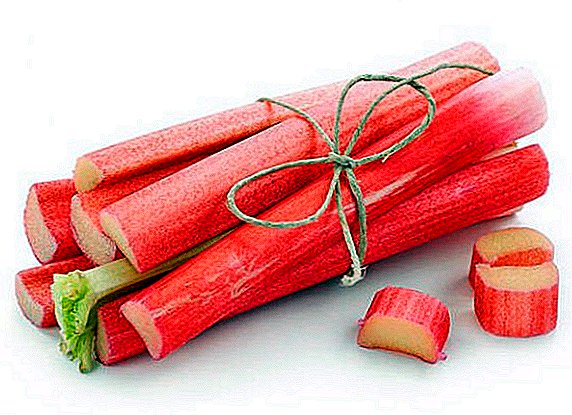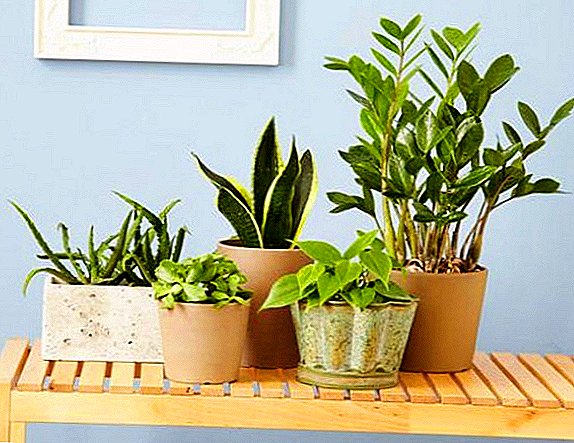 Potted flowers can be not only a great addition to the design of your apartment, but also a useful find. These plants create a cozy atmosphere for your home, add color to the interior and delight the eye at any time of the year. Of particular value are those flowers that can be beneficial to human health. Let's get acquainted with some of them.
Potted flowers can be not only a great addition to the design of your apartment, but also a useful find. These plants create a cozy atmosphere for your home, add color to the interior and delight the eye at any time of the year. Of particular value are those flowers that can be beneficial to human health. Let's get acquainted with some of them.
Chlorophytum
 The most unpretentious and most suitable plant for beginning gardeners is chlorophytum. It is a perennial grassy shrub with narrow green leaves and with hanging air whiskers, on which small bushes of a new plant are located.
The most unpretentious and most suitable plant for beginning gardeners is chlorophytum. It is a perennial grassy shrub with narrow green leaves and with hanging air whiskers, on which small bushes of a new plant are located.  Chlorophytum can grow in any soil, in any room: in the sun, in the shade, at warm or cold temperatures, on the refrigerator, on the table. He fits a pot of any size. The plant needs abundant watering, otherwise it may fade.
Chlorophytum can grow in any soil, in any room: in the sun, in the shade, at warm or cold temperatures, on the refrigerator, on the table. He fits a pot of any size. The plant needs abundant watering, otherwise it may fade.  An adult flower reaches a diameter of 50 cm and is the same size in height. Shoots grow in length from 80 to 100 cm. Chlorophytum has the ability to actively and effectively purify oxygen from harmful substances and carbon monoxide. Most often it is placed in the kitchen, where there is a gas stove, as the flower quickly absorbs substances harmful to humans from the air.
An adult flower reaches a diameter of 50 cm and is the same size in height. Shoots grow in length from 80 to 100 cm. Chlorophytum has the ability to actively and effectively purify oxygen from harmful substances and carbon monoxide. Most often it is placed in the kitchen, where there is a gas stove, as the flower quickly absorbs substances harmful to humans from the air.
Aloe
 The flower that is and should be in every home is aloe. It is a plant with branched, densely leafy, upright stems. The leaves, at the edges of which are hard cartilaginous teeth, reach a length of 40 cm and have a juicy, fleshy flesh.
The flower that is and should be in every home is aloe. It is a plant with branched, densely leafy, upright stems. The leaves, at the edges of which are hard cartilaginous teeth, reach a length of 40 cm and have a juicy, fleshy flesh.  Aloe, like all succulents, loves bright light and does not need frequent watering. It is necessary to moisten the soil of the pot 1-2 times a week in the summer and not more than once a month in the winter.
Aloe, like all succulents, loves bright light and does not need frequent watering. It is necessary to moisten the soil of the pot 1-2 times a week in the summer and not more than once a month in the winter.  Aloe juice is used as an effective remedy in the treatment of infections of staphylococcus and streptococcus, abscesses and phlegmon. This flower was widely used in dentistry in the treatment of stomatitis, periodontitis and periodontal disease. Moreover, aloe masks have anti-aging properties, help with local baldness and skin diseases. With the help of aloe, you can stop the bleeding, as tannins and catechins increase blood clotting.
Aloe juice is used as an effective remedy in the treatment of infections of staphylococcus and streptococcus, abscesses and phlegmon. This flower was widely used in dentistry in the treatment of stomatitis, periodontitis and periodontal disease. Moreover, aloe masks have anti-aging properties, help with local baldness and skin diseases. With the help of aloe, you can stop the bleeding, as tannins and catechins increase blood clotting.
Did you know? Alexander of Macedon conquered the island of Socotra only for the sake of aloe plantations, which were grown by local residents. It was with compresses from this plant that the conquerors treated the wounded soldiers after the victory.
Geranium
 Geranium is a useful and attractive indoor flower, which is distinguished by its unpretentiousness and a huge number of species. For good growth and maturation of geranium, it is necessary to place at room temperature, without drafts.
Geranium is a useful and attractive indoor flower, which is distinguished by its unpretentiousness and a huge number of species. For good growth and maturation of geranium, it is necessary to place at room temperature, without drafts.  The plant requires a large amount of sunlight, without which it can die. Soil any flower fits. Requires regular and frequent watering.
The plant requires a large amount of sunlight, without which it can die. Soil any flower fits. Requires regular and frequent watering.  Geranium is one of the most popular plants among traditional healers. It stimulates blood flow, normalizes heart rhythm, relieves headache. Flower is great tool for rhinitis, cough and sore throats, useful for otitis media. In addition, geranium has antiseptic, analgesic, diuretic, antibacterial and antidiabetic properties.
Geranium is one of the most popular plants among traditional healers. It stimulates blood flow, normalizes heart rhythm, relieves headache. Flower is great tool for rhinitis, cough and sore throats, useful for otitis media. In addition, geranium has antiseptic, analgesic, diuretic, antibacterial and antidiabetic properties.
Laurel
 The beautiful and useful decoration of your home will be laurel - a small shrub, densely covered with leaves of bright green color with a shiny surface and a peculiar aroma. The indoor view of this flower reaches a height of up to 2 m. It is best to grow laurel in a small flower pot, increasing its size as needed.
The beautiful and useful decoration of your home will be laurel - a small shrub, densely covered with leaves of bright green color with a shiny surface and a peculiar aroma. The indoor view of this flower reaches a height of up to 2 m. It is best to grow laurel in a small flower pot, increasing its size as needed.  The plant can adapt to any conditions and does not require frequent watering, but needs a sufficient amount of light and air. Laurel has the ability improve appetite, normalizes digestion.
The plant can adapt to any conditions and does not require frequent watering, but needs a sufficient amount of light and air. Laurel has the ability improve appetite, normalizes digestion.  Phytoncides that release its leaves are detrimental to the tubercle bacillus. Oil obtained from laurel has excellent antiviral, antibacterial and anti-inflammatory properties.
Phytoncides that release its leaves are detrimental to the tubercle bacillus. Oil obtained from laurel has excellent antiviral, antibacterial and anti-inflammatory properties.
Familiarize yourself with the best representatives of the flora for a sunny window and a dark room, bedroom, nursery, office, and also find out which plants cannot be kept in the house.
Ficus
 Thinking about what flowers should be in your house, do not forget about ficus. At home, the leaves of this plant can reach sizes up to 70 cm.
Thinking about what flowers should be in your house, do not forget about ficus. At home, the leaves of this plant can reach sizes up to 70 cm.  Ficus is ideally suited to a well-lit place at room temperature without direct sunlight, in the shade it can slow down growth and shed leaves. When caring for this flower requires regular watering as the top layer of soil mixture dries.
Ficus is ideally suited to a well-lit place at room temperature without direct sunlight, in the shade it can slow down growth and shed leaves. When caring for this flower requires regular watering as the top layer of soil mixture dries.  Ficus is very useful for room microclimate, as it actively cleans the air from impurities of benzene, trichlorethylene and phenol. Tinctures and mixtures of this plant help against mastopathy and prevent the appearance of malignant tumors.
Ficus is very useful for room microclimate, as it actively cleans the air from impurities of benzene, trichlorethylene and phenol. Tinctures and mixtures of this plant help against mastopathy and prevent the appearance of malignant tumors.
Important! Excessive watering of ficus can lead to decay of the root system.
Kalanchoe
 An indispensable healer in your home will be Kalanchoe, which is valued for its usefulness and usefulness. This flower is unpretentious, it requires a small amount of sunlight.
An indispensable healer in your home will be Kalanchoe, which is valued for its usefulness and usefulness. This flower is unpretentious, it requires a small amount of sunlight.
Learn how to grow different types of Kalanchoe in your home: Blossfeld, Kalandiva, Degremona, Cirrus.
Kalanchoe suits room temperature, even at 10 ° C it can be exposed to fresh air. Watering should be carried out regularly, but in no case do not flood the plant, it can lead to his death.  Kalanchoe leaves are able to accumulate moisture, which the flower can then use to survive during periods of drought. This is one of the few indoor plants that disinfects the air in the house and destroys microbes, copes well with the influenza virus.
Kalanchoe leaves are able to accumulate moisture, which the flower can then use to survive during periods of drought. This is one of the few indoor plants that disinfects the air in the house and destroys microbes, copes well with the influenza virus.  The most widespread Kalanchoe received as a remedy for the treatment of colds and rhinitis. At the same time it gives strength and vitality, helps to wake up easily in the morning.
The most widespread Kalanchoe received as a remedy for the treatment of colds and rhinitis. At the same time it gives strength and vitality, helps to wake up easily in the morning.
We advise you to read about the therapeutic properties of Kalanchoe Cirrus and Degremona.
Chrysanthemums
 There is hardly a person who has not heard of such a useful and popular flower for the house, like a chrysanthemum. This plant is fully adapted to life at home, prefers a cool temperature of 15-18 ° C and short sunny days. Keep it away from direct sunlight.
There is hardly a person who has not heard of such a useful and popular flower for the house, like a chrysanthemum. This plant is fully adapted to life at home, prefers a cool temperature of 15-18 ° C and short sunny days. Keep it away from direct sunlight.  For chrysanthemums drying of soil and root system is unacceptableIt requires regular watering and moisturizing. The plant has a beneficial effect on plasma, blood, bone marrow. It is used for headache, sore throat, eye infections, liver disease and nosebleeds.
For chrysanthemums drying of soil and root system is unacceptableIt requires regular watering and moisturizing. The plant has a beneficial effect on plasma, blood, bone marrow. It is used for headache, sore throat, eye infections, liver disease and nosebleeds.
Important! Some types of chrysanthemum have a very strong smell and can adversely affect a person, causing severe headaches. Be sure to ventilate the room with this flower before bedtime.
Cactus
 Perhaps, many people in the house have this kind of thorny plant. Cacti have adapted to room conditions, since this climate is close to their native semi-desert climate. They are extremely light-requiring and unpretentious to the temperature regime in which they are grown. In the summer, they require watering every 3-5 days as the topsoil dries.
Perhaps, many people in the house have this kind of thorny plant. Cacti have adapted to room conditions, since this climate is close to their native semi-desert climate. They are extremely light-requiring and unpretentious to the temperature regime in which they are grown. In the summer, they require watering every 3-5 days as the topsoil dries.  In cold or cloudy rainy weather cacti do not need moisture at all. The peculiarity of this plant is that its leaves are modified into spines of various lengths and colors.
In cold or cloudy rainy weather cacti do not need moisture at all. The peculiarity of this plant is that its leaves are modified into spines of various lengths and colors.  Cacti have a diuretic effect, are used for healing wounds, in diseases of the gastrointestinal tract, cardiovascular system, and neurological diseases. Broths from the stalk of a cactus effectively help in the treatment of colds.
Cacti have a diuretic effect, are used for healing wounds, in diseases of the gastrointestinal tract, cardiovascular system, and neurological diseases. Broths from the stalk of a cactus effectively help in the treatment of colds.
Pelargonium
 A very controversial plant is pelargonium, the specific smell of which quite the opposite affects different people. This is a perennial herbaceous plant, some species of which are represented in the form of subshrub. It can soothe and relax, as well as cause irritation or an allergic reaction.
A very controversial plant is pelargonium, the specific smell of which quite the opposite affects different people. This is a perennial herbaceous plant, some species of which are represented in the form of subshrub. It can soothe and relax, as well as cause irritation or an allergic reaction.  Pelargonium needs plenty of sunshine and room temperature. It must be watered every 3-4 days as the topsoil dries. The flower is used as excellent antidepressant and antisepticused for healing wounds.
Pelargonium needs plenty of sunshine and room temperature. It must be watered every 3-4 days as the topsoil dries. The flower is used as excellent antidepressant and antisepticused for healing wounds.  Pelargonium has excellent toning and deodorizing properties for the skin. In general, this room "doctor" has an anti-inflammatory effect on the body.
Pelargonium has excellent toning and deodorizing properties for the skin. In general, this room "doctor" has an anti-inflammatory effect on the body.
Did you know? Scientists believe that the history of growing plants at home has more than 5,000 years.
Sansevieria
 One of the champions in the production of oxygen and the absorption of harmful substances from the air is sansevieriya, or "pike tail". She is unpretentious in the care, looks great in the interior. Sansevieria has dark green leaves, collected in rosettes and growing directly from the rhizomes.
One of the champions in the production of oxygen and the absorption of harmful substances from the air is sansevieriya, or "pike tail". She is unpretentious in the care, looks great in the interior. Sansevieria has dark green leaves, collected in rosettes and growing directly from the rhizomes.  On the tips of the leaves of the flower there is a small point that cannot be broken, otherwise it will lead to a deterioration in growth. To maintain the beauty of the plant, it is necessary to provide it with plenty of sunlight and warm room temperature from 16 to 28 ° C.
On the tips of the leaves of the flower there is a small point that cannot be broken, otherwise it will lead to a deterioration in growth. To maintain the beauty of the plant, it is necessary to provide it with plenty of sunlight and warm room temperature from 16 to 28 ° C.  Sansevieria is drought-resistant, it needs little irrigation as the soil dries out. This flower is able to enrich your home. huge amount of oxygen, clear the air from benzene and formaldehyde. It effectively combats streptococci, staphylococci and other pathogens, has antimicrobial and antiviral effects.
Sansevieria is drought-resistant, it needs little irrigation as the soil dries out. This flower is able to enrich your home. huge amount of oxygen, clear the air from benzene and formaldehyde. It effectively combats streptococci, staphylococci and other pathogens, has antimicrobial and antiviral effects.
When choosing which indoor flowers are beautiful, and most importantly useful, to keep in your apartment, try to focus on what main effect you want to get from them. If you need natural "air purifiers", stop your choice on the chlorophytum, cactus or sansevieria. If you want to grow your own "doctor" from various ailments, you can use aloe, kalanchoe, laurel or pelargonium.


